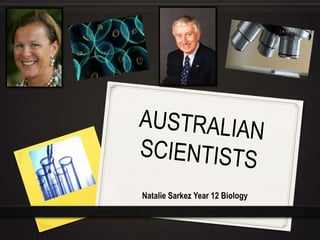
Australian scientist sresearch Natalie
- 1. Natalie Sarkez Year 12 Biology
- 2. Biology HSC Skills • Identify practising male and female Australian scientists, the areas in which they are currently working and information about their research. Task: 1. Identify 1 male and 1 female Australian scientists - Dr Fiona Wood - Dr Peter C. Doherty 2. Outline the areas in which they are currently working 3. Information about their research 4. How does their work impact society and/or the environment
- 3. FIONA WOOD “The quality of outcome must be worth the pain of survival”
- 4. Fiona Wood • Western Australian-Female plastic surgeon • Head of Royal Perth Hospital’s Burns Unit • Director of the Western Australia Burns Service • Australian of the Year 2005 • Fiona Wood Foundation
- 5. Outline the areas in which they are currently working: • Established The McComb Foundation in 1999, a plastic and reconstructive surgeon, together with scientist Marie Stoner. • 2012-was renamed the Fiona Wood Foundation- AIM: tries to improve the quality of outcomes for burn patients and improve patient quality of life. - Involved in a number of ongoing outreach projects - Provide support and training to medical staff in developing countries in relation to burns injury, with the aim of improving burn patient care, treatment and outcomes. Example: A specialist team from WA in 2011 visited Nepal and educated, trained and advised medical staff in the treatment of burn injury.
- 6. RESEARCH PROJECTS • The Genetics of Scarring: Collecting DNA samples from patients to identify genetic markers of poor scar outcomes -as individual variation in outcomes suggest that individual patient factors also play a large part in the rate of healing scars. Expanding trials in 2012 • The Nervous System Contribution to Recovery and Healing in Burn Injury: Nervous System including the brain, is integral to the development of every living tissue and psychological response to burn injury. Current studies include brain and sensory training to reduce the pain post burn. Completed studies have shown that the brain changes its neural activity in response to burn and to exercise. This research suggests a central nervous system mechanism is involved in peripheral nerve recovery after burn.
- 7. Bali 2002 How does their work impact society and/or the environment: • Significant impact in 2002 • Dr Wood and her team worked long hours to treat the survivors of the Bali bombings in 2002. • During this time, the “spray on skin” cell technology pioneered by Dr Wood was used in treating burns victims-a magnificent breakthrough which drew international attention. • The team worked hard to save 28 patients, suffering between 2% and 92% body burns, infections and delayed shock. • Dr Wood discovered that replacement of skin that could be provided within 10 days, greatly reduced scarring.
- 9. Peter C. Doherty • Australian male immunologist and pathologist • Nobel Prize for Physiology/Medicine in 1996 along with Rolf Zinkernagel, for their discovery of how the body’s immune system distinguishes virus-infected cells from normal cells. • Australian of the Year 1997
- 10. Outline the areas in which they are currently working: • Research focuses on the immune system • Nobel work described how the body’s immune cells protect against viruses. • Three months of the year, he conducts research at St. Jude Children’s Research hospital in Memphis, Tennessee • Other nine months, he works in the Department of Microbiology and Immunology at the University of Melbourne, Victoria • Researched the way killer T cells (orchestrates the immune systems response to infected cells) recognise and respond to viruses in mice. • T cells destroy infected cells so that the viruses cannot reproduce
- 11. THE DISCOVERY • In order for killer T cells to recognise infected cells, they had to recognise two molecules on the surface of the cell- not only the virus antigen (a toxin or other foreign substance that induces an immune response in the body esp. the production of antibodies). • A molecule of MHC (major histocompatibility complex)-(cells surface molecule encoded by a large gene family in all vertebrates contributing factor to discovery • Discovered the MHC was also responsible for the body fighting viruses too.
- 12. How does their work impact society and/or the environment: • Profound impact on immunology • Treatment of inflammatory diseases/diseases such as cancer • Today’s success in organ transplantation • Discovering how the body's immune system recognises the body cell and the foreign organism infecting the cell, which allows the body to eliminate the infected/invading cells and organisms respectively, but at the same time avoid damaging uninfected cells- had an immediate impact on organ transplantation success.